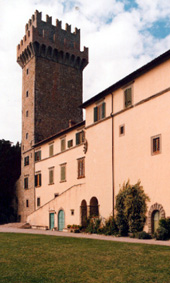|
|
|||
 |
SINGULAR AND DEGENERATE EVOLUTION PROBLEMS Registration |
||
|
|
|
|
|||
 |
SINGULAR AND DEGENERATE EVOLUTION PROBLEMS Registration |
||
|
In order to register (no conference fee is required), please copy and paste the text below, fill it in, and e-mail it back to
|
|
There is there is the possibility to present a very small number of short communications; if you would like to apply, the submission of an abstract before April 20, 2014is required. Abstracts should contain the title and the full author's address and not exceed one page. Please submit an abstract in plain text, TeX, or LaTeX to the conference e-mail: singdeg2014@gmail.com
|
|
The Roman poet Virgil considered Cortona founded by the mythical Dardano. The city subsequently became Umbrian, Etruscan and Roman, and then in 1200 a free commune under Uguccio Casali. The medieval history of Cortona ended with its annexation first to the Florentine Republic and then to the Grand Duchy of Tuscany. More than 2000 years of history are found in Cortona and this makes it one of the most unique and fascinating cities in central Italy.
|
|
by plane
Florence [FLR], Perugia [PEG], and Pisa airports [PSA] are the closest ones; Rome Fiumicino [FCO], Milan Malpensa [MXP], Milan Linate [LIN], and Bologna [BLQ] airports are also convenient - e.g. there are fast shuttle trains (no. 8 & no. 128) from Fiumicino Aeroporto directly to both Roma Termini and Roma Tiburtina railway stations [Note: for many destinations, transferring at Roma Tiburtina is faster and more convenient than Roma Termini]. In Milan, take the direct shuttle bus or train from Malpensa airport to Milano Centrale train station if you are transferring to a train; if you are going to stay in downtown Milano instead of taking a train immediately to another city there's an express shuttle which goes to several of the metro (subway) stations. In Florence, take the direct shuttle bus from the airport to the Santa Maria Novella (Firenze S.M.N.) train station. by train Train tickets can be purchased directly at any departure railway station. Remember that tickets must be stamped by the yellow devices located inside the station before getting on the train. by car From A1 (either north- or southbound) take the Valdichiana exit. After you pay your toll, turn to the right. At 0.5 km from the tollbooth take the Perugia Superstrada (direction Perugia). Continue on it for 12.3 km to the Cortona/Camucia exit. In just under 3 km you'll see Cortona on the hill. Follow the signs to Cortona; about 7 km further you'll be at the city walls.
|
|
To arrive at the Palazzone, the 16th century Villa Passerini, you should take the usual road for access to Cortona and just before coming into town you will find a place where three roads meet; here you take the little road going down to the right which has a yellow sign saying “Il Palazzone”; taking this road that leads to Contesse you will come to a fork where there is another yellow sign and go left for the Palazzone. It is on the South-East of Cortona and it is about 2 km from the town. As there is no bus connection between Cortona and the Palazzone, participants will enjoy a wonderful walk in the Tuscan country.
|
|
We offer a hotel reservation service. In case a participant needs such a service, he/she is kindly requested to point it out explicitly in the registration message. The speakers will be directly booked by the Organizing Committee.
|
|
During the meeting days June 23 - 27 lunch will be offered to all participants and served directly at the Palazzone. As for dinners, participants will easily find restaurants in town.
|
|
June in Tuscany may range from mild to hot. In general, we may expect temperatures in the mid 70's (Farenheit) or 25-30 (Celsius). We suggest also to bring some good walking shoes.
|